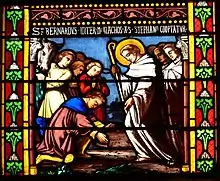Stephen Harding
Stephen Harding (French: Étienne Harding) (c. 1060 – 28 March 1134) was an English-born monk and abbot, who was one of the founders of the Cistercian Order. He is honoured as a saint in the Catholic Church.
Stephen Harding | |
|---|---|
 Saint Stephen Harding fresco in Apátistvánfalva, Hungary | |
| Born | c. 1050 Sherborne, Dorset, Kingdom of England |
| Died | 28 March 1134 (aged 83–84) Cîteaux Abbey, Duchy of Burgundy |
| Venerated in | Catholic Church (Cistercian Order) |
| Feast | 26 January (Solemnity of the Founders of Citeaux) |
| Attributes | Dressed in the Cistercian cowl, with miniature church model, holding abbot's crozier, holding the Carta Caritatis ("Charter of Charity"), a founding document for the Cistercian Order |
Life
There is little archival evidence, yet all sources agree that Stephen was English and spent some time at the monastery of Sherborne as a young man. The main source about his youth, William of Malmesbury, states that Stephen then went to France and became friends with another Englishman, called Peter. The two made a pilgrimage to Rome, took new religious names and then went to Molesme Abbey upon returning to Burgundy, around 1085.[1] On their return from Rome, they also experienced the monastic traditions of the Camaldolese and Vallombrosians.[2]
In 1098, Stephen went to the new monastery (soon to be known as Cîteaux) together with Robert and Alberic, was elected abbot in 1108, and died in 1134.[1]

Stephen was the third abbot of Cîteaux. Under his administration, very few novices were joining the community and the monks were suffering from hunger and sickness. In 1112, Bernard of Clairvaux entered the community, bringing with him thirty companions.
Between 1112 and 1119, a dozen new Cistercian houses were founded to accommodate those joining the young order. Harding's organizational skills were exceptional; he instituted the system of general chapters and regular visitations. In 1119, he received official approbation for the Carta Caritatis (Charter of Charity), an important document for the Cistercian Order, establishing its unifying principles.[1] Many of his policies and decisions were influenced from his time with the Vallombrosians.[3][4]
Stephen Harding served as abbot of Cîteaux for twenty-five years. While no single person is considered the founder of the Cistercian Order, the shape of Cistercian thought and its rapid growth in the 12th century were certainly due in some part to Harding's leadership.[5] He was the abbot who accepted Bernard of Clairvaux. Insisting on simplicity in all aspects of monastic life, Stephen encouraged the severity of Cistercian architecture and the simple beauty of the Order's liturgy and music.[6] He was an accomplished scribe; his highest achievement is considered to be the Harding Bible.[7] In 1133, he resigned as abbot because of poor eyesight.[8] He died on 28 March 1134.[8]
Veneration for Stephen began in the modern era. His feast was celebrated on 28 March until 1683 and then moved to 17 April, where it remained until the liturgical reforms following the Second Vatican Council, when it was moved back to 28 March.[9] In a joint commemoration with Robert of Molesme and Alberic, the first two abbots of Cîteaux, the Cistercians and Benedictines today celebrate Stephen Harding's feast day on 26 January.[10][11]
References
- The Cambridge companion to the Cistercian order. Mette Birkedal Bruun. Cambridge: Cambridge University Press. 2013. ISBN 978-1-107-00131-2. OCLC 795645066.
{{cite book}}: CS1 maint: others (link) - "Stephen Harding, St. | Encyclopedia.com". www.encyclopedia.com. Retrieved 21 November 2021.
- Duvernay, Roger (1952). "Cîteaux, Vallumbreuse et Étienne Harding". Analecta Cisterciensia (in French). Rome: Tipografia Poliglotta Vaticana. 8: 379–495. hdl:2027/mdp.39015024591888. Retrieved 21 November 2021 – via HathiTrust.
- Lekai, Louis J. (1969). "Motives and Ideals of the Eleventh-Century Monastic Renewal". Cistercian Studies Quarterly. 4: 3–20. Retrieved 21 November 2021 – via German National Library.
- Feiss, Hugh (2009). "Book review of Stercal (2008)". American Benedictine Review. 60 (2): 216–218.
- "Saint Stephen Harding | St Thomas & St Stephen". www.ss-thomas-stephen.org.uk. 30 September 2011. Retrieved 30 May 2017.
- "Manuscript Miniatures: Bible of Stephen Harding". manuscriptminiatures.com. Retrieved 21 November 2021.
- Huddleston, Gilbert. "St. Stephen Harding." The Catholic Encyclopedia Vol. 14. New York: Robert Appleton Company, 1912.
 This article incorporates text from this source, which is in the public domain.
This article incorporates text from this source, which is in the public domain. - Martyrologium Romanum (in Latin) (2 ed.). Administrationem Patrimonii Sedis Apostolicae in Civitate Vaticana. 2004. p. 208.
- "Jan 26 – Solemnity of the Founders of Citeaux – New Melleray". Retrieved 19 September 2022.
- Proper Masses for the Use of the Benedictine Confederation. Collegeville, Minnesota: The Liturgical Press. 1975. p. 9.
![]() This article incorporates text from a publication now in the public domain: Herbermann, Charles, ed. (1913). "St. Stephen Harding". Catholic Encyclopedia. New York: Robert Appleton Company.
This article incorporates text from a publication now in the public domain: Herbermann, Charles, ed. (1913). "St. Stephen Harding". Catholic Encyclopedia. New York: Robert Appleton Company.
Bibliography
- Claudio Stercal, Stephen Harding: A Biographical Sketch and Texts (Trappist, Kentucky: Cistercian Publications, 2008) (Cistercian Studies Series, 226).